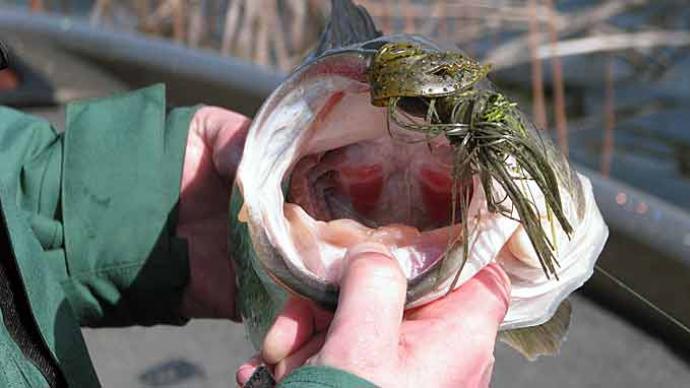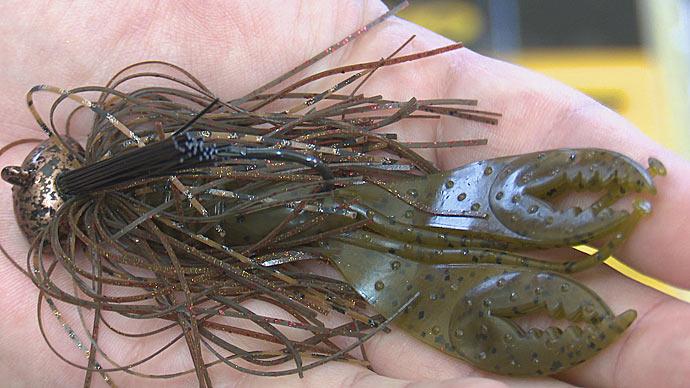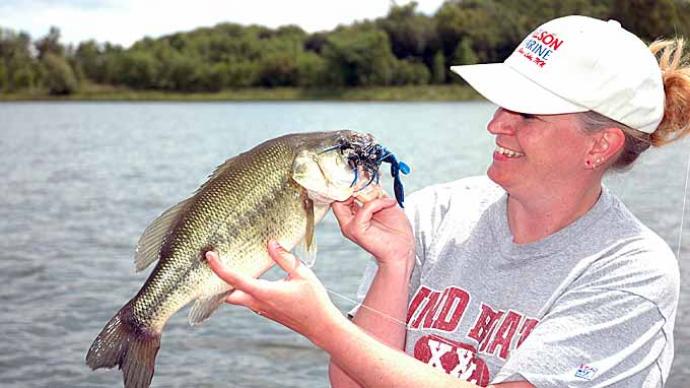
The following is an interview on the specifics of jig fishing between Jeff "Yakfish" Little and Craig "Earthworm77" DeFronzo.
Jeff: Why do you favor the jig more than any other lure?
Craig: I'm not sure I favor the jig over other baits. I consider myself a versatile angler and can fish pretty much any type of bait. Like all other lures, a jig-n-pig is merely a tool. When I recognize a situation where this tool can be utilized, I tie one on. Despite being known as a light tackle angler, I built much of my fishing reputation by jig fishing, so I'd confess that it is my specialty. I'm certainly at home fishing a jig-n-pig. I love setting the hook hard on a fish and then having the rod just bow over due to the weight of a chunky bass. I feel the jig produces larger average-sized fish than any other lure. That makes it exciting to know that you have a good shot at catching better fish on average.
Jeff: Rank the following jig attributes in importance when choosing a jig to tie onto your line: jig or trailer color, jig or trailer profile, weight, weed guard or not, type of material (silicone, hair, round rubber).
Craig: I'll throw you a curveball on this one. None of the choices you gave me is all that important to me. The one thing I'd rank the absolute most crucial characteristic of a good jig is the hook it is built on. When I set up my business, it happened by accident. I was making custom jigs for myself. That said, I was producing what, at the time, was a very high-quality bait that I simply couldn't find anywhere else. My friends let the cat out of the bag, and even though my business has grown tremendously since the late 1990s, I still go by the belief that I have to build them great because I fish them too.
After choosing your hook, which should be either a Gamakatsu or Owner Cutting point, I would say that weight of the bait and the overall profile are relatively significant. The weight allows you to saturate your intended strike zone more efficiently, and the profile is what may be the attracting factor to bass. Keep the bait in their interest zone as far as mimicking available forage. I'm elementary with color, usually black or RoadKill Camo. I prefer a weed guard, but I certainly can't say that using one or not attributes to more strikes overall. It depends where you fish it. You will need a weed guard if you use it in heavy cover.
I always match my trailer color to the skirt color: just a preference, no logic behind it. I don't think that bass avoid jigs because of their skirt material. I like Hydro Silk skirting. It is a round silicone similar to the older StarFlash skirts, minus the heavy glitter. The Hydro Silk is hollow and floats at rest. So here you have a material that when it is paused on the bottom, the skirt opens up slowly, which may be a factor in triggering strikes. I don't think a bass is sensitive enough to be able to discern rubber from silicone. Hair might be another story altogether. We'll leave it for another time.
Jeff: Pick your two favorite jigs and describe them. Then describe the perfect presentation and catch with each, including the rod/reel setup you use, the line used, the rod angle on the retrieve, the speed of retrieve, the hit, the hook set, and how you play and land the fish.
Craig: This is an exciting scenario because my options couldn't be more different from each other. The first would be a 1/16th ounce weedless jig like the original Micro Munch Jig that I built with the help of Charlie Nuckols of Float N Fly Fame. I wanted a light tackle jig-n-pig, which became the bait I built my company on. I teamed it up with a 2 ½" 40 strand silicone skirt and a Zoom Skinny Chunk trailer. We opted to use a single-strand wire weedguard rather than a large fiber guard. This bait was built for small stream smallmouth and largemouth, and I've taken literal tons of fish on them. I started using a 5-6 light action spinning rod with 6-pound mono. That worked well as this bait was good when skipped into wood cover. I could put this thing places where most anglers were afraid to go. That was the beauty of it. This bait penetrated areas that were never hit with baits. The chunky profile and the light weight keep it in the strike zone longer.
The bait was built because I was fishing a series of local streams that had immense overhead growth in the form of branches and vines. Skipping became the only natural way to make a presentation to these fish. I toiled to learn to set the hook awkwardly as well. However, once I got the hang of it, I started catching vast numbers of bass and some huge ones. I can skip a jig 20 feet behind an obstacle if I have to. You get adept at these things when you are forced to do them all the time.
These days I use a 6-6 medium Kistler Helium LTA He66MS. I match that up with a Shimano Sustain 2500. You can fish this bait on lighter gear if you wish, but I've found that you have the potential to catch some giant fish on it despite it being a small bait. Now that I'm in Florida, I recognize that the potential to take a fish over 10lbs exists daily, so I have upgraded my light tackle mentality to accommodate this reality. I go with 6lb Yo-Zuri Hybrid as far as the line. It over tests a bit, so anyone who appreciates braid might like this, plus it is relatively straightforward.
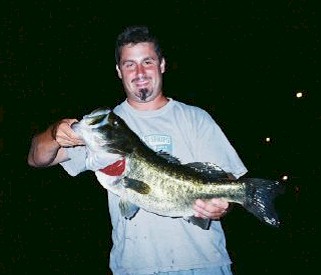
I like to use a 3/8 ounce Grass Jig of my design at the other end of the spectrum. I've found that this head comes through vegetation better than anything I've tried, and it is more than capable of being used in wood and rocky areas. As I said before, you have to have a good hook on any jig you throw. I built this head around a Gamakatsu Black Nickel Round bend. I like the round bend design, and I feel the Gammie is such a step above the Mustad that you see on almost every jig. It has a slimmer diameter carbon steel which allows better penetration, and with jigs, it's all about getting good penetration for solid hookups. I'm simple when it comes to color choices. I like Triple Black, RoadKill, Nuclear RoadKill, which has some green, black and orange thrown in and Black/Blue/Purple, which is more of a largemouth color. I've made some wicked colors for smallmouth that featured lots of bronze, orange, and even chartreuse. They can get crazy in the fall and hit wacky colors like that.
I use a 7ft MH Helium LTA He70MHC teamed up with a Shimano Scorpion MG or Antares 101 with 15lb Vanish Fluorocarbon. I don't use braid when jig fishing, just my preference.
The Grass Jig is always pitched, not flipped by me. I don't often swim the jig, but I don't let it simply sit there. If anyone ever heard of a doodle rig, I fish it like that. The doodle rig is a finesse tactic where the angler fish' a small worm on an open hooked jighead. The bait is jiggled and banged into rocks and things. I do the same thing with my Jig-n-pig's. I jiggle the rod tip ever so slightly like when a rattlesnake shakes its tail. It doesn't move much, but the point is obvious. The typical strike signals a little voice in my head (one of many) that goes THUMP. Once I get the thump signal, I set the hook hard over my shoulder, in business.
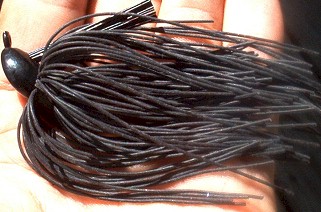
Jeff: For someone just starting with jigs, what advice would you give them to speed up their learning process?
Craig: Avoid fishing a jig like you would a plastic worm. They are both very different. A jig is the quintessential contact bait. Bass react to it and hit it differently than a plastic worm or grub. Learn to know what the jig feels like. I call this weighing the line. If you know what a 1/2 ounce jig feels like while working the bait, any lighter or heavier sensation is a reason to swing on it.
I've written hundreds of articles, and I get emails from guys who consider themselves good anglers but don't know how to fish a jig. My opinion is that you need to learn a jig to be a complete angler. It is a bread and butter lure.
Jeff: When designing a jig, what inspires you? What gives you ideas? Do you try to match the hatch or just come up with something that looks like it contains protein?
Craig: I can't say I've rocked the world with my jig designs. I have made three excellent jigs that a lot of guys are fishing. Generally, for me, this genre of baits is about putting together a total package rather than one unique facet or gimmick. In that sense, I think I've done well. This bait is essentially made of a hook, weed guard, skirt, and metal. I'm not so sure there can be any earth-shattering designs left in it. You can tweak things, but I like what I've got now. I would consider upgrading to an X-Point jig hook if they ever decide to make them for jigs. I'm always open to changing things up and improving my design, but the truth is that I haven't changed anything on the Rock Assassin or Grass Jig, and I have only changed the hook on the Micro Munch Jig. That is a testament to how secure I am with these designs.
I get ideas when I'm out on the water and encounter a problem that needs fixing. It may be something that I've thought about before but never could put together. Then one day, you see that little extra piece of the puzzle, and a light bulb goes off. It could be finding a way to present a bait better to fish deep inside cover or at a specific depth. Maybe you observe a bait being chased, and it moves a certain way that provokes a hard strike. I'm usually like Holy "S," why didn't I see that before. If you go out on the water and think you have it all figured out, I mean go out and fish and not learn anything, you might as well give up because this sport must be very dull for you. It is incredible how much I learn each time I go out. That is its satisfaction, putting it all together and having it work.
I built the Micro Munch Jig because I saw a need to utilize a light tackle jig-n-pig. The Rock Assassin was merely a natural progression for fishing for smallmouth in rocky areas. The Grass jig came about because I wanted to build a jig that stood up when it hit bottom. Despite being a weedless design, the grass head has a rounded back, which causes it to sit perfectly upright. This causes it to rotate upward when it hits something, often the bottom. This puts the jig in that fighting crawdad position that seems to generate a lot of strikes for me if I fish it on the bottom.
Jeff: What kinds of water/weather conditions force you to put down the jig rod and try different bait? In other words, even though a jig is one of the most versatile baits, are there situations when you will be more productive with a different type of lure? Give an example of such a situation.
Craig: I think the jig is a genuinely versatile bait, and I could fish it all year long and experience some degree of success with it. For me here in Florida, the heat is the killer. I compare it with winter in the North. I don't want to be on the water for either. When it gets sweltering, I put my jig rods down in favor of soft plastics. If I think I can catch them in the same places I throw a jig, I will opt for a tube like the El Gordo. I fish a ton of gin-clear rivers and usually won't throw a jig unless I'm targeting fish in deeper water on some type of structure. I usually can see them, which is sometimes difficult to comprehend and intimidating when they won't bite. I throw some crankbaits and spinnerbaits as well. I've been on a swimbait kick too.
We do not have smallmouth in Florida, but we do have Suwannee Bass and Shoal bass, which are similar in behavior. I will jig for Suwannees despite the heat. They are very susceptible to a lead and chunk attack any time of the year.
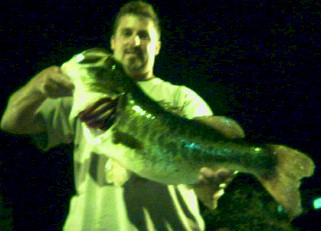
Like I said earlier, a jig is a tool. If the fish want something else and I recognize that, I'll switch up in a second. There are apparent signs that fish want something else when they are highly active and busting the surface—seeing that consistently should get the wheels turning to try something on the top like a fluke or a fast mover like a spinnerbait in a baitfish pattern.
Jeff: Describe your jig storage system. How are your jigs, trailers, or other components organized when you are on the water?
Craig: It is funny, I'm sure you're expecting some elaborate setup since I own a bait company, but it is relatively simple. I have a Plano 3600 series box in which I keep all of my heads separated by weight on the top. I keep my skirts on the bottom and allow them to be stored straight without bending. I don't store my jigs with the skirt affixed to the head. I use a jig and then get rid of it like I'll give it to someone. I very rarely keep the same jig tied on after a fishing trip. I kept fishing with the same jig when testing prototypes for my Grass Jig. I kept the same black jig on my rod for weeks. I was trying to roll the hook's point over and couldn't do it. I caught probably a 100 fish over 2 pounds on this one jig before I lost it.
Jeff: Discuss the different angles of the eyelet. Are there different applications for 90-degree angles from 0, 45, or 60-degree angles?
Craig: I'm sure the different anglers mean something in the grand scheme of things. I'll be ****** if I know what they are for. Certain angles are a bit more prone to hanging up. A 90 degree is the least snag friendly of the bunch. I prefer a flat eye on my jigs with a 45 to 60-degree angle. This gives me a good mix of weedless and outstanding hook-setting abilities. I won't go into its science, but I think the 45 or 60-degree angle sticks fish better than a 90 or 0.
Jeff: What about weed guards? Are you a bristle guy, a wire guy, or prefer to go without one? Again, are there different situational applications for each?
Craig: All big jigs get a fiber guard. Small 1/16 ounce jigs get a wire guard. I don't usually fish a jig without a weed guard unless it is a hair jig or a head that I'm fishing plastics on, like a Shakey head or Mushroom head. The consideration I make when picking a jig/weed guard is the tackle I'm using and the area I intend to fish. Serious snags require a fiber guard and light cover or light line necessitate a wire guard. The adage "Make love not war but be prepared for both" doesn't apply to my jig fishing. I use what is necessary to get by for a particular situation. If I'm jig fishing in water with few snags, I likely will either scale down totally or use a jig with a fiber guard that I clip some of the strands out of the "skinny it out." There is no need to use a beefy guard if you don't come in contact with a heavy cover. Going against this rationale, I often use a jig that may be under-equipped in heavier cover. This was the story of my early fishing days as I solely used a small jig with a wire guard to throw into some of the nastiest cover around. It worked for me far more than it didn't, so I adopted this "against then normal thought process" way of fishing the bait. Going outside the box is critical in staying fresh and focused in your fishing approach. I learned early that there are no rules in bass fishing and that what may work for one guy won't work for the next guy. This is mind. I tried to reinvent the wheel as it applies to my bass fishing.
In my opinion, weed guards don't protect you from weeds. If you fish in gak, you will get hung up no matter what you use to protect your jig. My consideration for a guard depends on the wood and hard snags I think I may encounter. This, in my opinion, is what a weed guard truly deflects.
Jeff: Talk a bit of lead head design. Arkie, ball head, football head, darter, mushroom head, banana head, the one with the eyelet inside the lead, etc. What is the best design for standing a bait up? What is best for punching through the grass? What is the least snaggy in rocks? What is best for swimming a jig? What about skipping under branches or docks? Are there hook set implications for different styles (i.e., do you set the same way regardless of head type, or is there a difference in hooksets?)
Craig: Each head may have a specific application, but many anglers simply use them because they work. I would argue that a Grass Head or Rocker Head stands up better than any other design. Although I'm not sure snaggy is a word, a football head likely comes through the rocks better than any other head. It fits. I prefer the ball head for skipping and fishing in open water. I don't care to use Arkies or Banana heads. I think you have to set the hook hard regardless of the choice of jig head (did you like that?). Your line will dictate how much pressure you put on it. You don't need to wallop fish to achieve good penetration with lighter tackle and fine diameter hooks.
When trying to get through grass or mats, anything with a streamlined design will be more resistant to catching snags. This is why the grass head was developed.
Jeff: Talk about the differences in profile, color, material, trailer, and weight of a jig that you would use for river smallmouth compared to flat water largemouth.
Craig: I think too many people stress separation between smallmouth and largemouth bass lures. I don't feel you can be species-specific with them, and I am more apt to use the same baits for both. I mean, what separates them? The difference physically is their mouths and attitudes but tell those guys who are chucking 2-ounce swimbaits designed for largemouth that they should not be able to catch smallmouth on a lure that big. You'll get laughed at. Besides, the fish you want to catch, the bigger ones, should have no problem eating something built with a green bass in mind. As this applies to my selection, starting, the hook is the basis of all of my jigs, no matter what I'm fishing for. With both a smallmouth jig and a typical flipping jig for largemouth, I would use the same Gamakatsu round bend hook. I like my jigs to be short and chunky, whether I'm targeting brown or green bass. A slow-moving mouthful is a better target, and it also helps slow the fall of the bait down a bit. I don't like to get too flashy with my color options. I believe in keeping my colors natural, and if I can match the hatch, I will. This usually adds a contrasting hand-poured chunk when fishing a RoadKill Camo jig for smallies. Maybe I'll throw in some purple flake to match a craw. Only in the fall will I stray and add something with a little orange or chart. We all know smallies seem to whack those good at the end of the year. I simply kill on solid black with a solid black chunk for largemouth. I rarely fish black and blue, and I don't need a pumpkin, watermelon, and Junebug. I know they work, but black works best for me.

I prefer Hydro Silk skirt material, as I said before. Rubber is ok, but I don't tie it, so I don't use it. I always opt for a plastic trailer over pork. Again just my preference. I don't like pork for what happens after you use it. Too messy and challenging to store and get off the hook. I hand pour the Muscle Craw and use salt and Kick N Bass scent. It is a wide-legged craw-type trailer. I recently found out another bait company copied the name from me.
I match the head's weight to the current flow for river bass and where I think the fish are. I even change the head style to a football, whereas I solely use the Grass Jig design for lake and pond fishing, maybe even slow flows. In the current, I start with a 3/8 ounce jig and try to figure out how quickly it gets down to the target. I'm looking for the quickest vertical fall that doesn't allow slack in the line, which is instrumental to successfully putting the jig on target in the current. If there is a smallie behind that rock, he will let you know if he wants that jig. The current forces these fish to react quickly, and he'll rap the jig pretty hard. This is why you can't have slack in the line.
I usually start with a 3/8 ounce for largemouth and scale down to a 3/16 ounce jig if I can. Occasionally I'll go heavier with a 1/2 ounce model to get the jig a little deeper or make it fall faster. Overall though, a 3/8 ounce jig sees the most duty on my line.
Jeff: Discuss the different applications of a fine wire hook vs. a heavier gauge hook.
Craig: I prefer a fine wire hook on the lighter jigs that I make. Whether it be a Float N Fly, rabbit hair jig, or a Micro Munch Jig, these light baits hang up if you fish them right, and on the correct tackle, you won't always be able to muscle them free. A light wire hook allows the hook to straighten out to a degree, and often it will be easier to get your bait back when you hang it up. A fine wire hook also penetrates much more accessible than a larger diameter model. This is essential when you are not using tackle with the beef to lay into a fish. I would prefer a hook that won't bend like a fine wire hook when fishing jigs with heavier tackle. A heavier gauge hook is the preferred choice of flippers and pitchers. I don't necessarily believe that this equates to a stronger hook. Strength depends more on the carbon rating of steel rather than the wire diameter. You can cheat and utilize more steel, but the end product is a hook with a larger overall wire diameter. To me, this is a disadvantage. Take a TTi X-Point, for instance. Here is a hook that uses the highest carbon rating at about 110. It is also the thinnest diameter compared to Mustad, Owner, and Gamakatsu of the same size. No doubt it is also the strongest. My point is that you don't need a thick diameter solely for strength. As I said earlier, thinner diameter wire penetrates more efficiently than thicker wire. So this may be a little misleading. I think the Gamakatsu has an excellent diameter to strength ratio, and it is readily available. X-Point doesn't make jig hooks. I recently took a 10-03 largemouth on my Grass Jig equipped with a Gamakatsu. I believe if I had been using a Mustad hook with a thick gauge wire hook, I likely wouldn't have been able to penetrate the fish's mouth.
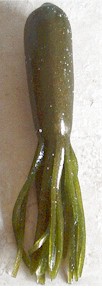
Jeff: Talk about the different hook styles (round bend, O'Shaunnesy, Matzuo Sickle or Barbarian, deep bite, wide gap, etc.), which ones you prefer, and why.
Craig: I prefer a round bend wide gap as bass are less likely to throw it. These types of hooks, like the Gamakatsu I like to use, have a big bite. I think it increases my hook-up success, and fish are less apt to throw it. I always say that a jig is one bite, one fish in the boat lure. When you get dialed in to fishing them, it is almost mechanical. I don't care for the Sickle hook on a jig. I build the Rock Assassin football jig with an EWG Gamakatsu hook as I think it is even more rock-proof than the round bend. This is the only jig I would use that hook on, though. It has a slightly smaller gap than the round bend and just doesn't hang up. I lose more of these because the head gets wedged in the rocks than I do with the hook hanging up.
Jeff: Do you use a different style or profile jig in the summer instead of spring or winter?
Craig: I pretty much stick with the Grass head all year. I change the head based on the cover I'm fishing, not the time of year. I'll throw a Rock Assassin Football jig when necessary. It started as the cousin to the original Micro Munch Jig and evolved into a smallmouth-only jig for me. I would have to say that my preference of the Muscle Craw chunk, a wide profile trailer, keeps all of my jigs looking similar in profile. I think it is spring and winter, you need a reasonably slow fall that maximizes the baits time in the strike zone, and the chunky profile allows this to happen.
Jeff: Do you like to throw tubes at all, and are there situations when you would choose a tube over a jig?
Craig: (giggling) Tubes? Yeah, I throw a ton of tubes. I like tubes over jigs when the water is warmer. I likely would throw a tube up north before I'd sling a jig for smallmouth. In Florida, I pitch a tube in the hotter weather rather than a jig. I use a Gambler Florida rig weight that essentially pegs the weight to the hook eyelet. Here, the plastic tube is just a better summertime bait. It's funny, but I can't go into a tackle store in my area and find a jig on the shelf. For whatever reason, it isn't a popular bait in my locale. In September of this year, I took a 10-03 on one of my jigs, so I know the fish will hit them.
Jeff: Do you use scents or rattles on your jigs? If so, describe what kinds you use.
Craig: I rarely use rattles on my jigs. Occasionally, if I'm fishing some dirty water, I might choose a rattling jig. However, generally, a jig wouldn't be my first option in dirty water. I'd prefer something with excessive vibration and flash like a spinnerbait. I always use a hand-poured trailer that I pour called the Muscle Craw. It has salt and scent cooked into the plastic, and then it is scented again before it is packaged. I like to believe that anything that gives me an extra second or two to set the hook is worth it, and I feel scent may give me this advantage.
Jeff: Thanks, Craig! I know your answers will provide plenty of insight and ideas to the bass fishing community.


